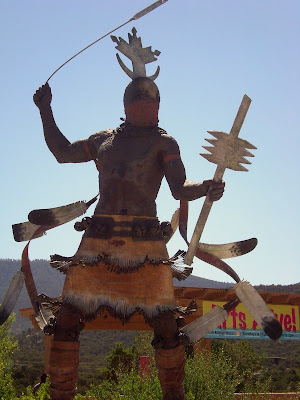The Pueblo has a land base covering 431,664 acres and is home to 4,800 tribal members, while only approximately 30 or so people live permanently on the mesa now. A reservation surrounds the mesa, with tribal members living both on and outside it. The Pueblo itself has more than 250 dwellings, none of which have electricity, sewer or water. Access to the mesa is by a road blasted into the rock face during the 1950’s, on tours conducted through the Sky City Cultural center at the base of the mesa.
Acoma Pueblo has three rows of three-story, apartment-style buildings which face south on top of the mesa. The roof for one level would serve as the floor for another. Each level is connected by ladders. Baking ovens are outside the buildings, with water being collected from two natural rock cisterns. Acoma also has seven rectangular kivas and a village plaza which serves as the spiritual center for the village.
It is believed Coronado's expedition, in 1540, was the first European contact with the Acoma. The Pueblo had contact with Spanish explorers heading north from Central America; all generally peaceful interactions. The only access to the Acoma Pueblo during this time was a set of almost vertical stairs cut into the rock face.
By 1598, relationships with the Spaniards had declined. In December of that year, the Acoma heard that Juan de Oñate had intended on colonizing the area. The Acoma ambushed a group of Oñate's men, killing 11 of them. The Spanish took revenge on the Acoma, burning most of the village, killing over 600 people and imprisoning approximately 500 others.
Survivors of the Acoma Massacre would recover and rebuild their community, and Oñate would proceed to force the Acoma and other local Indians to pay taxes in crops, cotton and labor. Spanish rule also brought Catholic missionaries into the area. The Spanish renamed the pueblos with the names of saints and started to construct churches at them.
Our delightful and informative tour guide - wish I would have gotten his name. You are deposited at the top of the mesa, via tour bus, and the entire walking tour is approximately 3/4 mi. long, and took us approx. an hour and a half, give or take. The day we went, it was overcast and threatening to storm...perfect weather for the hot mesa top! Photography is permitted through a permit obtained with ticket purchase, though there are restrictions.
As a side note to the history of the Pueblo, my Dad purchased a beautiful, old pot from the window of one of the residences when I was with my parents on our very first trip to this Pueblo, as a child. You were allowed to travel to the top without tour guides at that point, and the residents were happy to display their wares for sale, much as they do today. This trip, my Dad was delighted to find the same exact house, with the original family...where I had him pose with mother and daughter potters from whom he purchased a new bowl to go with the antique purchased years ago. Photo top left is one of the natural water cisterns; photo bottom right is an oven.
Another of the natural formed stone cisterns, utilized by the mesa for collecting water when it rains.
Between 1629 and 1641 the San Estevan Del Rey Mission Church was constructed. The Acoma were ordered to build the church, moving 20,000 tons of adobe, straw, sandstone and mud to the mesa for the church walls. Massive Ponderosa pines were carried in by community members, on foot, from over 40 miles away. At 6,000-square-feet, with an altar flanked by 60-foot-high wood pillars handcarved in red and white designs representing Christian and Indigenous beliefs, the structure is considered a cultural treasure by the Acoma, despite the slave labor used to build it. One of the sadder stories to come from this tour was the forced trade of several small Acoma children in return for the church bells. Photography is prohibited inside the church and the graveyard outside - take my word, it's something to see. .jpg)
Getting there: Pueblo of Acoma, I-40, Exit 102, Acoma, NM 87034
HOURS OF OPERATION: Sunday through Saturday from 9am – 5pm. Tours begin at 9:30am and continue throughout the day. The final full tour of the day is conducted at 3:30pm. The Cafe hours of operation are 11am - 4:30pm. Acoma Pueblo observes traditional annual events, so hours of operation are subject to change. Please check our calendar for closures, or call 1-800-747-0181.
WINTER CLOSURE: The Sky City Cultural Center is closed from November through February. No Pueblo tours are conducted during this period.


.jpg)
.jpg)



.jpg)

.jpg)

.jpg)

.jpg)

.jpg)
.jpg)
+(800x376).jpg)
.jpg)
.jpg)
.jpg)
.jpg)










.jpg)


























